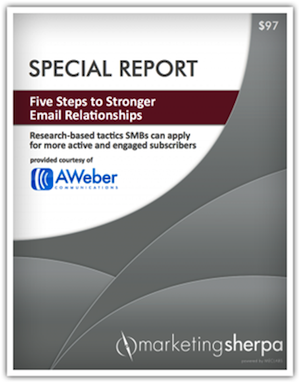Aweber and MarketingSherpa have released a special report and five-part email series on how to create stronger relationship with email. The report is based on a survey of over 2,700 email marketers, and features in-depth analysis, the latest benchmark data, and five actionable step to creating a strong email relationship with your readers.
Research reports from MarketingSherpa normally cost $97. However, Aweber is making it available for free to their customers. The information and advice in the report are dead on, and you should definitely download a personal copy to add to your success library.
Here are some of the highlights from the report.
 Approach list building strategically
Approach list building strategically
There’s no shortage of tactics for growing email lists, but it’s all too easy to get caught up in them at the expense of a fully developed plan. Does your 2012 email strategy account for how and when to apply certain tactics, and when to test others? Does it include a consistent process for analysis and adjustments?
With less than a third of email marketers saying they send relevant emails to segmented audiences with a clear conversion goal, this is an area ripe for improvement.
Set clear expectations for subscribers
As marketers, we don’t always see the disconnect between how our offers are presented and how prospects perceive them. For instance, many email forms ask for name and email, yet offer little context or information about send frequency, specific content options or recent samples. These forms might generate larger lists, but produce lower overall response and engagement.
We may know the value of the content behind the opt-in form, but is it obvious to first-time site visitors who see a pop-up window before even reading one paragraph?
Segment lists to match your priorities
Whether you’re segmenting lists based on behaviors, such as opens, clicks and downloads (or lack thereof), or stage in the sales cycle, or more specific demographic data, the bottom line is that segmentation is essential for tailoring content to different types of customers.
Matching segments to your organization’s ideal customer personas makes your content more engaging and your offers and campaigns more likely to succeed. So why are only about half of email marketers using these techniques regularly?
Automate your campaigns
Welcome, thank you and transactional emails are widely used by organizations of all sizes, but research shows a significant drop-off in other types of automated messages.
Lead nurturing, drip campaigns, re-engagement campaigns and autoresponders make it easier for marketers to create email series with the intent of building relationships; however, these types account for roughly one-third or fewer of the emails sent by survey respondents.
If your content mix includes “evergreen†information such as how-to articles or training videos that won’t lose their news value, automation is an option worth exploring.
Optimize and test regularly
To quote the report, “Continuous experimentation is the quickest path to peak performance.†Yet only 28% of small businesses regularly test and optimize email messages. Mid-sized and larger organizations fared better, although only about half of them are testing regularly.
Deadlines and full workloads are a common culprit, but let’s say you run a test that produces an 18% lift in response – you’d probably find time to test more consistently next time, right? Interestingly, subject lines are among the most popular email tests, yet they often produce the smallest gains, compared to areas such as landing pages and target audiences.